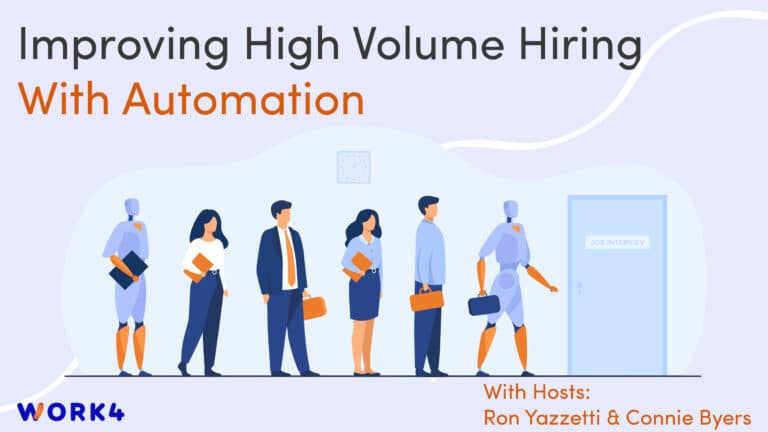The hiring process refers to the steps it takes to find, select and hire new employees for your company. Developing your process requires strategic and pragmatic thinking since every quality new hire has the potential to contribute positively to growth and profitability while poor hires can have a negative impact on your company. By taking the time to define the steps in your hiring process, you’re taking the first step in positioning your business for success by attracting and selecting the right talent. A well-defined hiring process will help to streamline the way you source, qualify and hire candidates.
Each business is unique, and therefore will each have its own unique way of implementing a hiring process, however, there are five key steps you should follow to help ensure your success:
- Planning – Define/create and identify the role to be filled.
- Sourcing – Market, promote, and recruit for your open position.
- Screening – Determine how well a candidate may fit the advertised position.
- Verification – Confirm the information top-choice candidates have provided.
- Selection – Carefully evaluate candidates for the position.
When creating or rebuilding your approach to hiring, start by developing a basic understanding of the five-step hiring process. From there, follow these best practices to optimize hiring within your organization.
# 1 – Planning
Identify Hiring Needs
The hiring process begins as soon as you identify a need within your organization. Whether hiring for a recently vacated position, scaling for growth, or a newly created role that helps better manage your team’s workload, the process starts here.
Create a Recruitment Plan
Once a hiring need has been identified, it’s time to plan your recruitment strategy. Creating a plan for hiring will not only make the process more efficient but will also help give you an understanding of the current as well as future staffing needs of your company. In the case of newly formed positions, start with clearly identifying the goals of the new role and how they align with the business plan.
Specify required skills, experience, qualifications, compensation, whether the position is temporary or permanent, and any other special conditions. If you’re filling a recently vacated position review that all the above-listed factors are still current and relevant in your description.
Define the Position
Spending the time to create a clear description of the position will save you countless hours during the screening process. Clearly list and explain the job responsibilities, desired qualifications, work experience salary, and benefits. If the position you’re hiring for is temporary check out:
# 2 Sourcing
Promote the Position Externally
In today’s competitive job market, promoting your position is arguably one of the most important aspects of the hiring process. Before you begin, research where the best candidates are searching for similar roles, you always want to meet your target audience where they are. External promotion and publicity of the position can occur on any combination of the following:
- The company’s website
- Social media platforms
- Job boards and posting sites
- Industry publications and events
- Job Fairs
- Local newspaper advertisements
- Word-of-mouth
Partner with the experts at Work4 for insights into the best marketing channels for your industry.
Advertise the Position Internally
Identifying highly qualified potential candidates can be as close as your own walls if you begin your search internally. Your existing staff is a great pool to pull talent from, after all, they are already invested in your company.
# 3 Screening
Resume Screening
The screening of applicants starts with an established list of qualifications that a successful candidate must have in order to do the job. The purpose of screening a resume is to determine if the applicant has the basic knowledge and skills needed to do the job you’re trying to fill. During the screening, if the applicant lacks any of the qualifications on your must-have list, they should be eliminated from any further consideration. Once a batch of qualified applications is assembled you can move forward with the following stages.
Interviews
Depending on the size of the organization and hiring committee, one more interview can be scheduled for your top-choice candidates. When planning a job interview, there are several things that you should always take into account prior to conducting it. Firstly, you’ll need to determine whether you will be conducting a live or a phone interview. Next, decide how long it will last and what type of knowledge will you be examining during the interview. To help through this process consider creating a list of interview questions like this one in advance.
There are three crucial elements that every candidate must possess to succeed within any given position: knowledge, skills, and attitude. During the resume screening, you’ll be determining if a candidate has (or at least claims to have) the basic knowledge and skills to do the job. However, the interview is where you’ll determine if he or she really does. In addition, the interview is the best place to determine attitude.
# 4 Verification
Background Check
If a background check is required for your position, be sure to indicate in your initial job posting that all candidates are subject to a background check.
Reference Check
Research from Resume Lab shows that up to one-third of applicants embellish their employment history. Reference checks are a great way to verify any relevant information shared regarding previous employment – job performance, experience, responsibilities, workplace conduct, etc. Additionally, some organizations also check a candidate’s social media accounts (Facebook, Twitter, etc.) to make sure potential employees are likely to represent the company in a professional manner.
# 5 Selection
The Job Offer
After all of the screening, interviews assessments, and checks, it’s finally decision time! Once a decision is made a job offer can be extended.
Hiring
Once the candidate accepts the job offer they are officially hired. Now the process of filling out and filing relevant paperwork can begin. This includes but is not limited to:
- W-4 Form
- Form I-9 and E-Verify
- State Withholding and Registrations
- An organization’s employee handbook
However, your job is not done yet. Contrary to the beliefs of some, the hiring of a new employee does not conclude the hiring process.
Onboarding
Onboarding is the time when a candidate is introduced to the culture and people of your organization. During this time focus on giving them all of the important information and training, they’ll need to excel at their new job. Welcoming new hires in a professional way helps integrate them in a manner that lays the groundwork for a long-term productive relationship between them and your company. Lastly, consider assigning your new employee a mentor who can help them settle into their new position and set them up for long-term growth and success.
Defining the Steps in Your Hiring Process
A detailed hiring process is a necessary element for any brand’s success. Devising and implementing a consistent hiring plan will help optimize your ability to identify the strongest candidates. If you follow the five steps above to define the hiring process in your organization not only will it help you to minimize the risk of making a poor hiring decision, but it can also help save your business time, money, and resources. Streamline your recruitment process by partnering with Work4. We offer complete recruitment marketing services to help you hire the right candidates right now.







